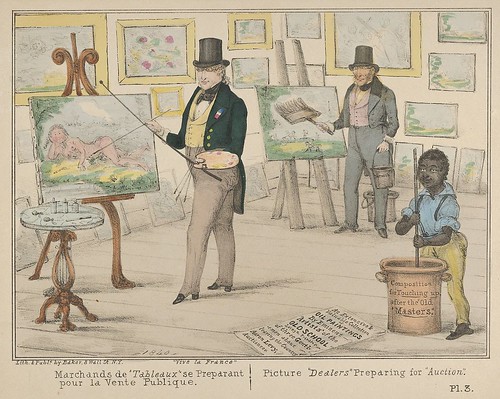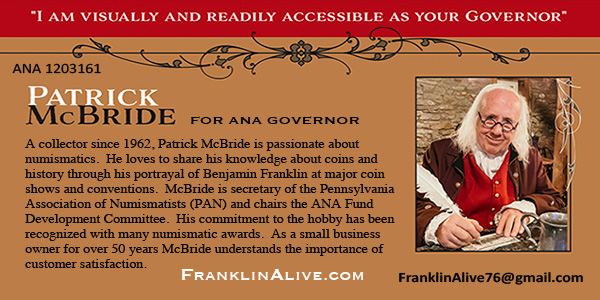
Here's the first of three summaries of articles by Joel Orosz on Bushnell's Compendium Catalog, originally published in our print journal, The Asylum. While The E-Sylum is free to all, only paid members of NBS receive The Asylum. To join, see
https://www.coinbooks.org/about/membership.html
.
This one opens with Joel's introduction.
-Editor
INTRODUCTION
ChatGPT Summary of Associations Columns
On Bushnell's Compendium Catalog
Published in The Asylum
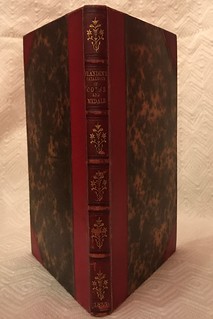 Beginning with the Winter, 2021 issue of The Asylum, I dedicated my occasional
Beginning with the Winter, 2021 issue of The Asylum, I dedicated my occasional Associations column
to an examination of one of the more intriguing literary survivors of the cradle days of American
numismatics. During the 1850s, as numismatics in the U.S. was emerging as a national hobby, New
Yorker Charles Ira Bushnell was the leader of the pack: a voracious collector, a scholarly author, and one
of the first American collectors of numismatic literature. He tried to save every auction sale featuring
coins, priced and named, if possible, and bound them together in his distinctive Bushnell Bindings.
These octavo-sized volumes boasted spines and corners of gold-tooled red morocco leather, with sides
embellished with red and blue marbled paper. One of the first such volumes he put together was
labeled Flandin's Catalogue on its spine, but in fact contained priced and named copies of three auction
sales: those of Pierre Flandin (June 6, 1855); Daniel E. Groux (February 15, 1856), and Winslow Howard
(May 17, 1856).
Any one of these sales is a rarity in itself, but to have all three together, along with pertinent ephemera
(handwritten notes, newspaper clippings, bookplates), truly makes this Compendium Catalog a one-of-a-kind. Flandin's was the first public auction held in New York City that consisted exclusively of coins.
Groux's, printed on a broadside folded several times to fit into the catalog, is so rare that Emmanuel J.
Attinelli, in Numisgraphics, could only guess that the collection belonged to Groux. Howard's was
heretofore known only from a passing mention made by Bushnell in one of his books, but had never
been spotted in the wild. The Bushnell Compendium Catalog containing all three was sold as lot 2939 of
the Chapman Brothers sale of the Bushnell Collection, June 20-24, 1882, but its contents were not
appreciated until it became part of the John Lupia II numismatic library during the current century.
My Associations columns in The Asylum have followed a format consisting of a biographical treatment
of the collector (Bushnell, Flandin, Groux, and Howard), followed by an examination of the sale
associated with each. This has resulted in six columns published in as many issues, with the seventh and
final to appear in the Summer 2023 number. In all, 70 pages are already in print, with the final column to
add about 15 more. All are well-illustrated from the Compendium Catalog and from kindred resources.
The biographical installments present consignors who varied from a pioneering dealer in the fine arts; to
a con-artist and convicted bigamist; to a Western path-finding lepidopterist. Their collections likewise
ranged widely from coveted coppers; to Mexican rarities; to trashy tin-foil rubbings.
Since the majority of E-Sylum subscribers are not members of the Numismatic Bibliomania Society, and
thus have not had access to these Associations columns, Wayne Homren asked me to write a pithy
summary. Even a bare-bones summary, however, felt like starting a marathon just after completing an
Iron Man Triathlon, so initially I demurred. Wayne then hinted that the latest Artificial Intelligence
sensation, ChatGPT, might be up to the job of summarizing this imposing mass of verbiage. Alas, my
technical skills only slightly outpace those of Fred Flintstone; but I was saved by my old friend and
writing partner, Len Augsburger, Coordinator of the Newman Numismatic Portal. Even Len's formidable
skills were put to the test in properly feeding all seven columns into ChatGPT's portal, but in the end,
real intelligence triumphed over the artificial sort.
The Associations series on the Bushnell compendium Catalog (including the last installment not yet
published in The Asylum), was summarized by Chat GPT in a seven page document (reduced from the
approximately 85 pages of the original). It has done a workmanlike job of summarizing the columns,
albeit at a 10th grade level of writing. I have elected to edit the output only in those places where
ChatGPT produced actual errors of summarization. This resulted in a total of seven minor changes
spread about evenly through the document. While none of the writers for The Asylum or The E-Sylum
should fear for their jobs, ChatGPT produced a competent précis of the originals. I hope that reading
these summaries, which I have illustrated with a selection of photos that accompanied the original
Associations columns, might tempt some of those who have not yet joined the Numismatic
Bibliomania Society to sign up and thus subscribe to our quarterly journal, The Asylum.
THE CATALOG
The article is a review of Charles Ira Bushnell's Flandin's Catalogue of Coins and Medals. The book is a
collection of three rare numismatic sales from the mid-19th century, curated by Bushnell, and contains
detailed descriptions and prices of each item, as well as the names of the buyers. The article notes that
the book is unique and contains one-of-a-kind ephemera, including a bookplate, an ALS from Bushnell to
Flandin, and newspaper clippings. The author, Joel J. Orosz, considers the book to be an essential
document for American numismatics.
THE CREATOR
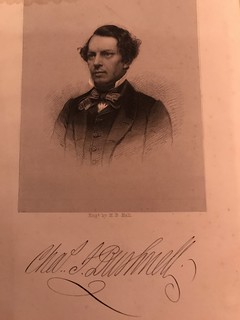 Charles Ira Bushnell was a New York City-based attorney who became an advanced coin collector
starting in the late 1840s. He actively gathered a vast collection of coins, medals, and tokens, although
he kept a low profile. He built a comprehensive library of catalogs and articles on American coinage and
published An Arrangement of Tradesmen's Cards, Political Tokens, Also Election Medals, Medalets & c.
Current in the United States of America, for the Last 60 Years in 1858, which became the first substantive
work on American tokens. He also wrote An Historical Account of the First Three Business Tokens Issued
in the City of New York in 1859. Bushnell was known for his extensive knowledge and was highly
regarded in the numismatic community. He participated in coin auctions, and his dedication to collecting
led him to become a leading figure in the hobby.
Charles Ira Bushnell was a New York City-based attorney who became an advanced coin collector
starting in the late 1840s. He actively gathered a vast collection of coins, medals, and tokens, although
he kept a low profile. He built a comprehensive library of catalogs and articles on American coinage and
published An Arrangement of Tradesmen's Cards, Political Tokens, Also Election Medals, Medalets & c.
Current in the United States of America, for the Last 60 Years in 1858, which became the first substantive
work on American tokens. He also wrote An Historical Account of the First Three Business Tokens Issued
in the City of New York in 1859. Bushnell was known for his extensive knowledge and was highly
regarded in the numismatic community. He participated in coin auctions, and his dedication to collecting
led him to become a leading figure in the hobby.
PIERRE FLANDIN
Pierre Flandin was a French-born art dealer who set up the first art gallery in New York City in 1811,
dealing mainly in old master paintings. He was known for his sharp dealings with his customers, who
complained that he over-attributed paintings when he was selling them, only to downgrade them when
he bought them back. Among his clients was Robert Gilmor Jr., a Baltimore financier and collector of old
master paintings, who distrusted Flandin for much of their long relationship, but continued to patronize
him. Flandin's success was partly due to his careful control of costs and his diversification of sources of
income.
The Merchandise Tableaux caricatures Flandin's business practices as an art dealer. Flandin is the man in the background applying varnish to a painting with a huge brush. It is one of only two known surviving images of Flandin.
PIERRE FLANDIN SALE (part 1)
The article discusses the history of numismatic auctions in the United States, with a particular focus on
the sale of Pierre Flandin's collection in 1855. Numismatic auctions were not common in the early days,
with coins often sold as a part of a larger auction. The first auction to feature numismatic items
exclusively was the sale of Philip Price, Jr.'s collection in 1813 in Philadelphia. The numismatic scene was
active in the mid-19th century, and the Flandin sale was the first primarily numismatic auction sale in
New York City and the third in the United States. The article notes that there were discrepancies in the
catalog of the Flandin sale regarding the total realized amount, which was identified as $733.52 by
Emmanuel J. Attinelli.
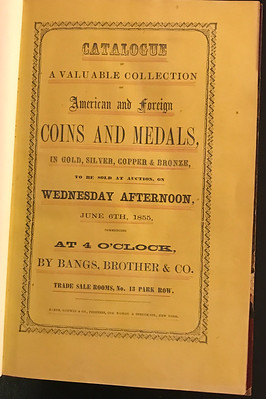
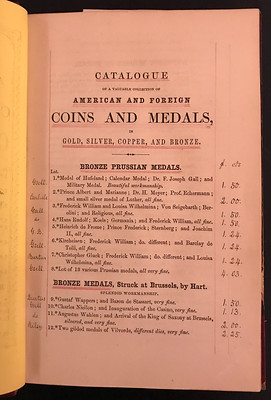
The Flandin Sale Catalog
PIERRE FLANDIN SALE (part 2, buyers)
The text discusses Bushnell's Flandin's Catalogue, which records twenty-one different buyers at an
auction in 1855, using surnames only. These buyers can be divided into four categories: Numismatic
Notables, Known Numismatists, Usual 1850s Suspects, and Eternal Mysteries. The Numismatic Notables
category includes Charles Ira Bushnell, Dr. James R. Chilton, John K. Curtis, and Winslow Howard. The
Known Numismatists category includes Louis Borg, P.F. (probably Pierre Flandin), Michael Moore, and
Thomas Riley. The Usual 1850s Suspects category includes Burtus, Carlisle, and Gsell. The Eternal
Mysteries category includes unidentified participants or possibly pseudonyms for bidders wishing to
remain anonymous.
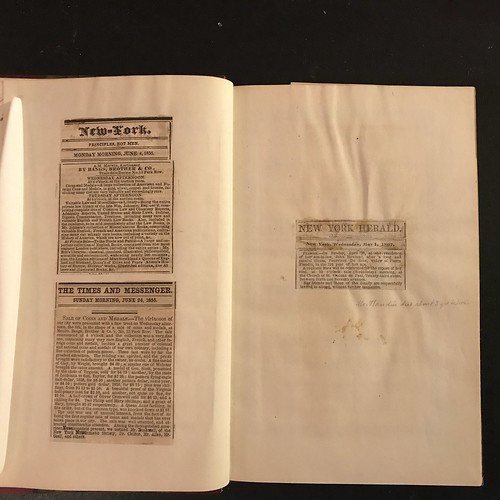
Flandin Sale Clippings
BUSHNELL'S FLANDIN CATALOGUE
Charles Ira Bushnell's catalog of Pierre Flandin's coin collection includes various items besides the
catalog, such as an autograph letter from Flandin, his bookplate, and newspaper clippings. Bushnell was
pleased with his purchases from the Flandin sale and documented his catalog with notes and
underlining. One of the newspaper clippings was a detailed report on the Flandin sale, with prices
realized for many lots. Finally, Bushnell priced and named the lots in the catalog, and embellished the
cover and pages with ruling in red ink.
BUSHNELL AND THE NY NUMISMATIC SOCIETY
The article discusses the history of numismatic societies in America, with a particular focus on the New
York Numismatic Society. The author presented evidence that the society was in existence prior to the
Numismatic Society of Philadelphia and the American Numismatic Society, which were previously
believed to be the first two organized numismatic associations in the United States. The article describes
the formation and dissolution of the second New York Numismatic Society, and the subsequent revival
of the American Numismatic and Archaeological Society. The author presented evidence of the New
York Numismatic Society's existence in a classified ad placed in 1853 and in John Livingston's Law
Register in 1854.
Wayne Homren, Editor
The Numismatic Bibliomania Society is a non-profit organization
promoting numismatic literature. See our web site at coinbooks.org.
To submit items for publication in The E-Sylum, write to the Editor
at this address: whomren@gmail.com
To subscribe go to: https://my.binhost.com/lists/listinfo/esylum
Copyright © 1998 - 2024 The Numismatic Bibliomania Society (NBS)
All Rights Reserved.
NBS Home Page
Contact the NBS webmaster
|




